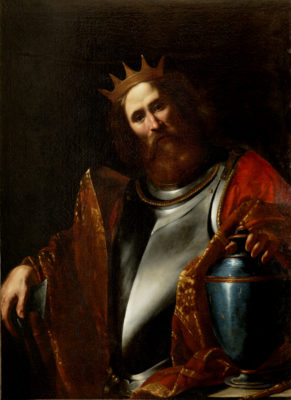Orazio RIMINALDI
(Pisa, 1593-1630)
King Clovis.
C. 1625.
Oil on canvas, 52¾ x 38 5/8 in (134 x 98 cm).
This beautiful image of King Clovis is certainly unusual in Italy, and the choice of iconography would appear to have been because the patron was a French national, present in Rome between the end of the 1610s and the latter half of the 1620s. That the figure is indeed Clovis is irrefutable – apart from the axe, the attribute of the Barbarian king, the identification is due above all to the vase on the right, on which the figure rests his hand. This is the vase of Soissons, symbolic of the rapprochement between the pagan Merovingian king and the Christian clergy. In 486, after a victorious war (ending precisely with the Battle of Soissons) that allowed the young Clovis to extend his dominion to all of Northern Gaul, the Bishop of Rheims Remigius (Rémi) requested that the monarch return the vase taken from one of the city’s churches.
The vase was considered war loot, and the king promised the bishop to return it only if it were assigned to him by the assembled warriors. Clovis made a specific request for the vase, and the assembly accepted it, their consensus underlining the monarch’s superior authority over the other Frankish combatants. However, one of them refused, insisting on the tradition of drawing lots for the loot, and by implication the equal rank of all the combatants. Clovis had to assent, but in the following year, before the entire united army, he cruelly revenged himself on the rebel, killing him and instilling terror among those present, who could thus gauge the king’s power over all the noble warriors. The Christian clergy had already sided with Clovis after the victory at Soissons, and became one of his fundamental allies. For his part, in 496 (or 498; the year is uncertain) the king had himself baptised by Remigius in Rheims.
As was stated above, the rarity of the subject in Italian iconography should not lead us to suppose the painting’s author was French, even if this might seem a feasible hypothesis. The choice of subject would have been made entirely by the patron, who was presumably from north of the Alps, or at least closely connected with France and the ecclesiastical establishment. Elements of style point to the authorship of Orazio Riminaldi, who must have painted this in the mature years of his Roman sojourn, that is, in the mid-1620s, considering its similarity to Simon Vouet, whose work was studied by our Pisan painter in these years.
The recognition of Riminaldi’s authorship is based above all not only on the treatment of colour – slightly humid, glowing, and toned down to deeper, thicker shading, which precisely matches what one sees in Orazio’s canvases – but also on the unmistakable correspondence of style in Clovis’ face, with its highlights created by white lead brushstrokes on the shaft of the nose and eyelids, which make the skin dense and luminescent. These elements recur in the Samson in the Tribune of Pisa Cathedral (the resemblance of the facial types is undeniable), but also in the shiny skin of the protagonists in the Bolognetti Fable of Eurydice introduced by the present writer at the Ariccia exhibition in 2006. Clovis’ potent hand, with its prominent nail, also corresponds to similar passages elsewhere in Riminaldi’s oeuvre, for example in the nude lying in the foreground of the Samson mentioned above. The most convincing comparison is surely that of the face of Saint James (though tilted in the opposite direction to that of our figure) in the Saints James and Anthony Abbot in the Museo di San Rufino. Assisi: here we can really imagine that the same model posed for both paintings.
Riminaldi’s interest in Guido Reni, and certainly in Simon Vouet too, visible in the painted banner in Assisi – homage to the French artist is especially noticeable on side A, with the Martyrdom of Saint Catherine of Alexandria – is also evident in our picture, datable to the period of the Umbrian work, which was very likely painted for Marcello Crescenzi, Bishop of Assisi between 1591 and 1630. The dating of the Assisi banner, established around 1625 by Filippo Todini, Liliana Barroero and myself, may thus be shared by the King Clovis before us.
Gianni PAPI
